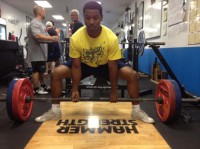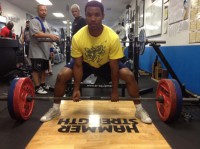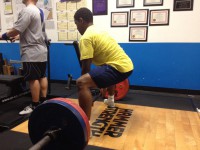The crowd had no idea. The judges – they didn’t know either. Hell, the lifter didn’t even know.
But I knew.
I knew this was a huge PR. I knew this was for the win – for the Texas State Championship. I knew my lifter could pull this deadlift, and with it, not only finish 9/9, get her first 600lb total, her first 300 Wilks score, and finish the trifecta – PR’ing her squat, bench, and dead all in the same meet, but also – she could win the freaking meet.
And she did.
I coached my special lady friend Jessica this weekend at the USAPL TX State Meet, and it went well – really well – and I’m proud of her, naturally. Luckily, there are lessons to be learned here by any competitor.
First: You have to make your lifts. The most successful powerlifters (and most of the best Olympic lifters) usually make more attempts than their competition. How do you make lifts? You have a plan, and you start conservatively. Jessica and I had talked for weeks about her squat and bench attempts. She was so confident in her 2nd attempts that there was no chance of missing them. They also happened to be 2.5kg meet PRs – what I call “chips,” meaning the smallest PR possible. Her training taper was based around these attempts – and also for modest 3rd attempts that were well within her reach.
Jess squatting >200lbs for the first time. She lost her tightness out of the hole a bit and still fought for 3 white lights.
Second: Preparation. You can’t go into a meet having never touched 500 pounds and expect to pull 600. The Texas Method approaches that Justin and I use make sure that lifters get used to heavy weight before a meet. Jess squatted 185×2 about a week out (as part of an ascending 3×2 day) and it looked like the easiest thing in the world. When 204 was loaded on the bar, it was a perfect third call. Tough, but possible, and she ground it out for her first 200+ squat (and a 7.5kg meet PR!). On her bench, as I said, she had a 2.5kg meet PR on her 2nd, at 45kg/99lbs. Our “best case/worse case” plan called for either 47.5 or 50kg on her third, and as bad as she wanted the bigger number, after watching her second, I called for 47.5kg – which she nailed. This brings me to my next point.
Third: Trust. Trust in your coach (or handler – and yes, they’re different). Trust in your training. Trust in your taper. Trust in your strength. When I called for the 47.5kg bench instead of 50kg, Jess didn’t fight me – she trusted that I saw that her second attempt wasn’t as fast as I wanted to see, or as she thought it felt. She trusted that I knew 50kg might just be a little too much that day, and that she’d need every kilo for her total. She promptly went out and smoked 47.5kg, and will get 50kg (and then some) at her next meet. As her coach, I ensured that she (finally) got her first 100+ pound competition bench, and she thanked me later.
Trust came into play even more with the deadlift. She had suffered an injury with a kitchen knife – she nearly cut off the tip of her middle finger while unloading the dishwasher – and hadn’t been able to pull very much at all for about a month before the meet. She’d pulled 280 in the gym before the accident, and we decided that, best case, we’d go for 127.5kg/281lbs on her third as a very modest PR, but only if things went perfectly. Guess what? We never called 127.5.
Fourth: Awareness. Shit comes up in a meet. With Jess, she understands that she isn’t always the strongest person in her class. She competes to improve her own total, and to consistently hit PRs. She has a blast chipping away at each meet and slowly improving her total. Powerlifting, like every strength sport, takes years of practice for most to become the best, and Jess is patient. However, you must always be aware. For this meet, she was scheduled to lift as a 60kg/132lb lifter. Once the roster came out, I saw that the class was stacked, and asked her to lift in the 67.5/148 class. There were only 2 other ladies pre-registered in the class, so I knew she’d at least get a third place medal, and without having to suffer to make weight, she’d have an even better shot at big PRs. She stuffed her face all week, ate a ½ pound hamburger the night before (with two desserts!), and weighed in at 60.9kg Saturday morning. As soon as the squats started up, I knew she actually had a chance at taking the class. One girl, who was much stronger than Jess or the other, didn’t have much experience, and bombed out, leaving Jess and another lady to battle it out for first.
We stuck to the plan for the squat and bench, and Jess was 6/6 going into deads, 15kg out of first place. At this point, I gave her a set of headphones, sat her in a corner, and told her to stop looking at the projectors. She nailed her light 110kg opener, and her competitor opened up at 102.5 – cutting the lead down to 7.5kg. I had done my research on Jess’s competitor and had an idea of what she’d pull, and what Jess would need to pull to win. Knowing that the other woman had weighed in over Jess, I decided before deads even started that, on the third, I’d call for whatever it took to tie (and therefore win on bodyweight).
After the first pull, I called for a jump to 122.5kg (270lbs). Jess had been expecting ~117.5, but I was playing to win.
I told her to get cranked up (specifically, I said “What would Ben do?” Ben is another of my lifters that will deadlift almost anything I put on the bar) before the second pull, and she did – and made it look easy, giving us both confidence going into the third. Her injured finger held up, and her competitor had only taken a 10kg jump – dropping the lead to 5kg. I saw that she called for a 5kg jump on her third. If she missed it, Jess would need a 5kg increase (127.5/281) for the tie/win. If she made it, Jess would need a 10kg bump (132.5/292). I called for a small 2.5kg increase, so that Jess’s third only showed 125 on the scoreboard.
This is where it’s important to be aware. In the USAPL and most other federations, you can change your third deadlift call almost right up until you lift (technical note – read the rules, but basically, you can change it up to twice, until the bar is loaded or your name is called). Since there was another lifter in the flight between her competitor and Jess, I had plenty of time to change the final attempt. In this case, the other woman pulled her third successfully (with a lot left in the tank), and I immediately increased Jess’s third deadlift to 132.5kg/292lbs, without telling her what was going to be on the bar.
She got jacked up, yanked the earphones out, and I looked deep into her eyes. She knew this was going to be something heavy, and she knew it was important. But most importantly, she knew that I believed she could pull it. She stomped to the chalk bowl, breathed in as much oxygen as she could…
And she got it.
Jess makes her winning pull look easy.
I’m extremely proud of Jess for having the mental fortitude to have such a great meet. She trusted me, as her coach, to handle her attempts to put her in the best situation (in regard to both personal records and overall standing), and she got “in the zone” when needed. She followed our standard hydration and nutrition (read: forcing herself to get all the hydration and calories throughout the day), and she walked away with a gold medal. You can only beat who shows up – and most importantly, you should never beat yourself.
Coach, Lifter, and Hardware.











